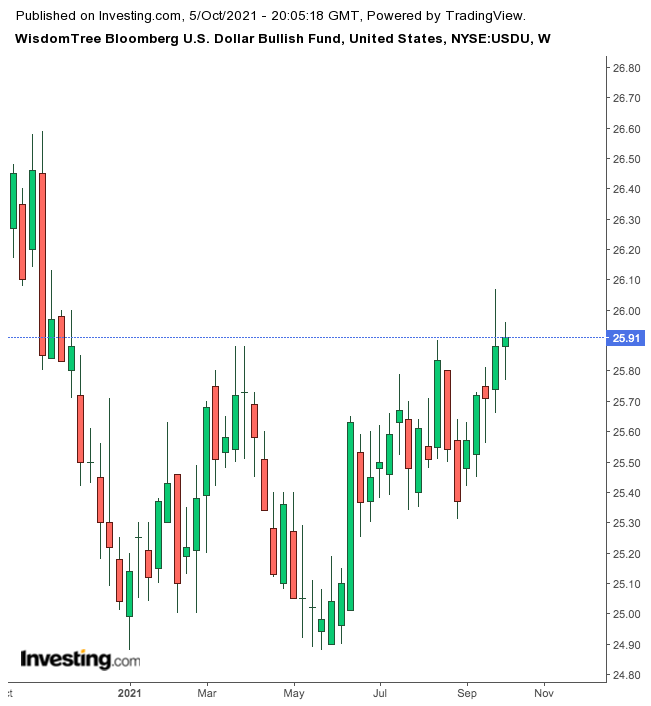Currency exchange-traded funds (CETFs) have become popular among investors who want to participate in FX moves. According to the Bank for International Settlements’ Triennial Survey of 2019, global daily foreign exchange trading is worth more than $6.5 trillion. And London has a tight grip on these transactions, accounting for well over 4% of global FX turnover.
Research by Robert B. Burney of Coastal Carolina University suggests:
“Because currency ETFs typically have small minimum transaction sizes and trade like equities, they represent an easily accessible alternative for the small investor or small business operator.”
We previously discussed several funds that could be appropriate for:
- US dollar bulls and bears (covered here and here)
- Japanese yen bulls and bears (covered here and here)
- British pound sterling bulls (covered here)
Today, we introduce two more funds for US dollar bulls and euro bears. In recent weeks, Wall Street has been watching the greenback surge against many currencies, in part, due to rising expectations for interest rate hikes in the US.
Expected tapering by the Fed is likely to provide further tailwinds for the dollar as well.
Finally, investors who buy CETFs that bet on the strength of the dollar sometimes use these funds as a potential hedge against declines in equities. Given the recent volatility in many US stocks, investors debate whether a significant decline in equities could be around the corner.
With that information, here are two currency ETFs.
1. WisdomTree Bloomberg US Dollar Bullish Fund
Current Price: $25.91
52-Week Range: $24.88 - $26.63
Dividend Yield: 0.66%
Expense Ratio: 0.51% per year
The WisdomTree Bloomberg US Dollar Bullish Fund (NYSE:USDU) gives exposure to moves in the US dollar against a basket of foreign currencies from both developed and emerging markets. The fund, which benefits as the US dollar appreciates, tracks the returns of the Bloomberg Dollar Total Return Index.

USDU began trading in December 2013. Its net assets stand at $112.1 million. This currency ETF saw a 52-week high of $26.63 exactly a year ago, on Oct. 6. It hit a 52-week low of $24.88 in late May. So far in 2021, USDU has returned 3.67%.
By comparison, the Invesco DB US Dollar Index Bullish Fund (NYSE:UUP) is up 3.96% this year. As previous articles have discussed in detail, UUP provides exposure to the US Dollar Index futures contracts that trade on the ICE Futures US exchange. That index does not have exposure to emerging market currencies.
Investors who are bullish on the greenback could consider investing in USDU around these levels.
2. ProShares Short Euro
Current Price: $44.02
52-Week Range: $40.56 - $44.24
Expense Ratio: 0.95% per year
The ProShares Short Euro (NYSE:EUFX) is an inverse ETF (covered recently here). Its objective is to achieve daily investment results, which correspond to the inverse (-1x) of the daily performance of the price of the euro versus the greenback. Put another way, the fund benefits when the euro grows weaker relative to the US dollar.

So far in 2021, EUFX is up 6.44%. As currency market moves tend to continue over long periods, the weakness we’re seeing in the euro against the greenback could continue for some time.
Short-term traders who are bullish on the USD might want to research the fund further.
Note that inverse funds are not appropriate as long-term holdings and are better suited for daily traders. Therefore, they are not appropriate for most investors.
